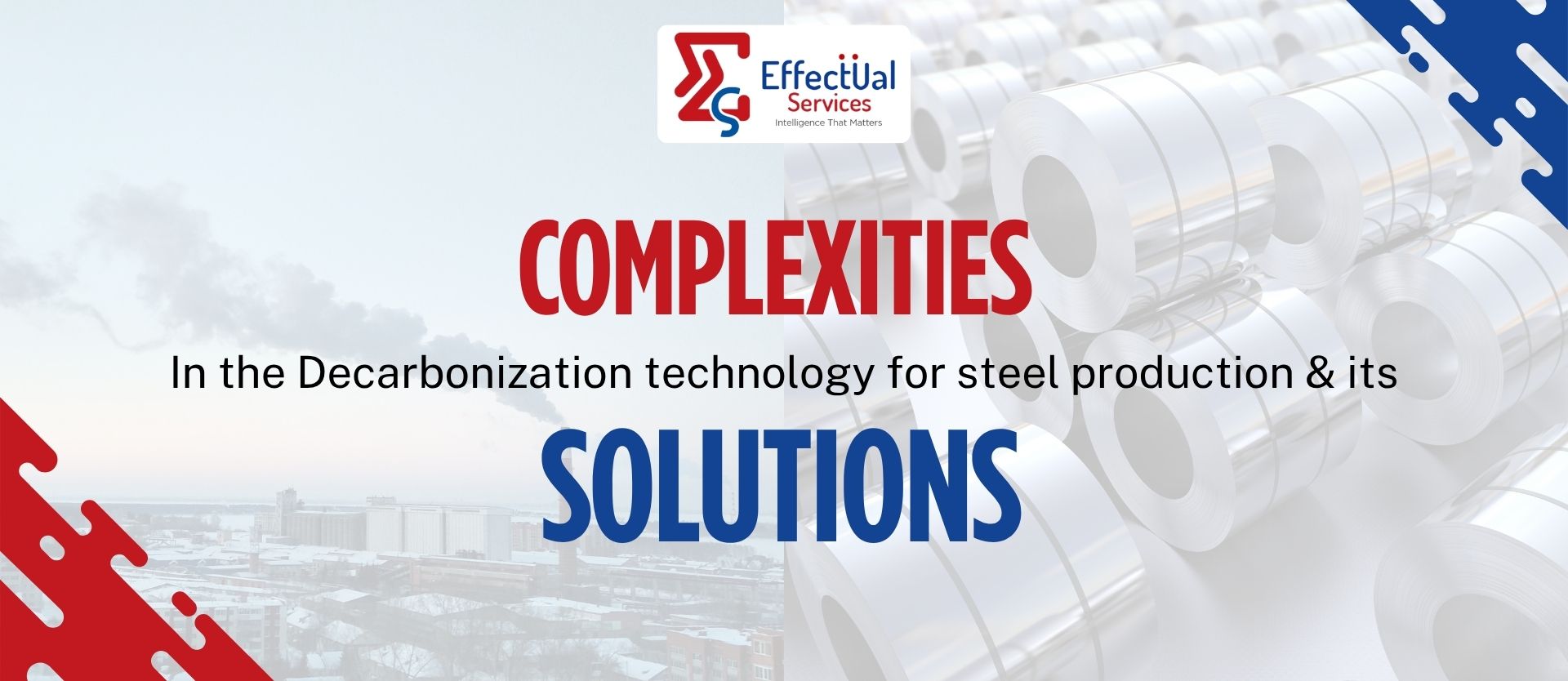Complexities in the Decarbonization technology for steel production and its solutions

Background Study (3/5)
Decarbonizing the steel industry is critical for reducing global greenhouse gas emissions, and while the challenges are significant, there are several promising solutions and strategies to address the complexities. Below are potential solutions to solve the key issues identified earlier:
1. Hazardous Electric Arc Furnace (EAF) Dust
Complexity: EAF dust is a hazardous byproduct containing toxic metals like lead, cadmium, and zinc. Proper disposal or treatment is essential to prevent environmental contamination.
Solution: Advanced dust capture systems and recycling processes (e.g., the Waelz kiln process) can extract valuable metals from the dust, reducing the environmental impact and converting waste into reusable materials. Research into improved dust filtration systems and safe disposal methods also helps mitigate this proble.
2. Limitation in Carbon Capture, Utilization, and Storage (CCUS)
Complexity: CCUS technology is not yet widely deployed in steel production due to high costs, technical challenges, and scalability issues.
Solution: Developing more cost-effective and efficient CCUS technologies is key. Innovations like direct air capture (DAC) and integration with renewable energy sources can reduce the carbon footprint. Additionally, public-private partnerships and government subsidies can help scale up CCUS technology, making it more economically feasible for steel plants.
3. Low Efficiency and Scalability of Hydrogen-Based Direct Reduced Iron (DRI) Technology
Complexity: Hydrogen-based DRI technology, while promising, suffers from low efficiency, high energy requirements, and scalability issues, particularly in producing large quantities of steel.
Solution: Continued R&D into more efficient hydrogen DRI processes, including higher-temperature electrolysis and advanced catalyst development, can improve efficiency. Integrating renewable energy sources like wind or solar to power hydrogen production can also lower emissions while improving scalability.
4. Difficulty in Hydrogen, availability, Storage and Transport
Complexity: Hydrogen availability, storage and transportation pose technical and economic challenges due to its low energy density and flammability, which require specialized infrastructure.
Solution: Innovations in solid-state hydrogen storage, such as metal hydrides, and advancements in cryogenic or compressed hydrogen transport methods are promising solutions. Developing a global hydrogen infrastructure, with pipelines and storage facilities, will also facilitate more efficient transport.
Background Study (4/5)
5. High Energy Requirement
Complexity: Steel production, particularly with Electric Arc Furnaces (EAFs) and hydrogen-based technologies, requires vast amounts of energy, making it challenging to decarbonize using only renewable energy sources.
Solution: Increasing the share of renewable energy, such as wind, solar, and hydropower, is crucial to decarbonizing steel production. Battery storage systems can also smooth out renewable energy supply fluctuations, ensuring consistent power for energy-intensive processes like steelmaking.
6. Increased Production Time
Complexity: Some decarbonization technologies, like carbon capture or hydrogen-based DRI, may increase production time compared to traditional methods.
Solution: Optimizing production processes through digitalization and automation can reduce delays. Advancements in process integration and smart plant operations can streamline workflows, minimizing the impact of decarbonization technologies on production time.
7. High Implementation Costs
Complexity: Implementing decarbonization technologies often involves significant upfront capital expenditure for new equipment, retrofitting, and operational adjustments.
Solution: Leveraging government incentives, subsidies, and carbon credits can offset high costs. Companies can also explore partnerships and collaborations to share the financial burden of developing and deploying new technologies. Over time, scaling up these technologies should help reduce costs.
8. Difficulty in Integration with Traditional Plants
Complexity: Many decarbonization technologies require major adjustments to traditional steel plants, which can be disruptive and costly.
Solution: Modular technologies that can be integrated incrementally, without requiring a complete plant overhaul, are a practical solution. Flexible technologies that work with existing infrastructure, such as hybrid hydrogen-carbon systems, can allow for a gradual transition to decarbonized production.
9. Loss of Product Quality/Grades
Complexity: Some low-carbon steel production methods may result in a loss of quality, such as reduced strength or variability in grades, particularly when using scrap-based EAFs.
Solution: Improved sorting and processing of scrap steel can enhance the quality of steel produced via EAF. Additionally, R&D into refining processes and alloy adjustments can help maintain or even improve product quality when using decarbonized methods.
Background Study (5/5)
10. Challenges in Industrial Scalability
Complexity: Scaling up decarbonization technologies from pilot plants to large-scale industrial production is a significant hurdle, particularly in maintaining cost-effectiveness and operational efficiency.
Solution: Pilot projects and collaboration between industry leaders and technology providers can help demonstrate scalable solutions. Establishing standardized protocols and benchmarks for scaling low-carbon technologies can aid in reducing uncertainty and accelerating deployment.
11. Adaptability in Using Technology for Multiple Types of Steel Product Production
Complexity: Decarbonization technologies may not be easily adaptable for producing different types of steel, such as carbon steel, stainless steel, or alloy steel, which have varied production requirements.
Solution: Developing flexible technologies that can adjust to different steel production requirements is critical. This can include adaptable furnace designs and smart control systems that can handle different types of raw materials and production conditions without compromising on efficiency.
12. Adaptability in Using Technology for Multiple Steel Sources
Complexity: Steel production often relies on different sources of raw materials, such as iron ore and scrap. Decarbonization technologies must be adaptable to various inputs.
Solution: Enhancing material sorting and refining technologies can allow for more efficient use of different raw materials. Flexible process designs that can handle varying input quality without significant performance losses are essential for wider adoption of decarbonization technologies.
13. Supply Chain Challenges
Complexity: A sustainable supply chain is essential for decarbonizing steel production, but many components, such as renewable energy or hydrogen, Scrap material may have inconsistent availability.
Solution: Strengthening supply chain resilience through partnerships with renewable energy providers and hydrogen producers can mitigate these issues. Additionally, localizing supply chains and reducing dependence on distant or volatile resources can improve reliability and reduce risks associated with decarbonization efforts.
A multi-pronged approach is necessary to address the complexities of decarbonizing the steel industry. This includes accelerated technological development (especially in hydrogen-based processes and CCUS), robust government policy and financial support, investments in renewable energy infrastructure, and fostering collaboration across the value chain. By solving these challenges, the steel industry can make significant progress toward producing green steel, contributing to global climate goals and ensuring its long-term sustainability.
Explore Part 1: Complexities of Decarbonization Technologies in Steel Production Overview
About Effectual Services
Effectual Services is an award-winning Intellectual Property (IP) management advisory & consulting firm offering IP intelligence to Fortune 500 companies, law firms, research institutes and universities, and venture capital firms/PE firms, globally.
Through research & intelligence we help our clients in taking critical business decisions backed with credible data sources, which in turn helps them achieve their organisational goals, foster innovation and achieve milestones within timelines while optimising costs.
Our Services
Solutions Driving Innovation & Intelligence
Enabling Fortune 500's, R&D Giants, Law firms, Universities, Research institutes & SME's Around The Globe Gather Intelligence That
Protects and Nurtures Innovation Through a Team of 250+ Techno Legal Professionals.

